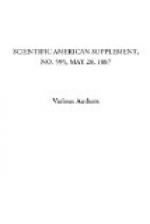2. That the so-called incubative period is very definite and regular, being just a fortnight from infection to eruption.
The old experiments of inoculation practiced on our forefathers have taught us that from inoculation to the first appearance of the rash is just twelve days. Given a case of small-pox, then one has only to go carefully over the doings and movements of the patient on the days about a fortnight preceding in order to succeed very often in finding the source of infection.
In the fortnight ending February 5, 1881, forty-one houses were attacked by small-pox in the special mile circle round the hospital, and in this limited outbreak it was found, as previously, that the severity of incidence bore an exact inverse proportion to the distance from the hospital.
The greater part of these were attacked in the five days January 26-30, 1881, and in seeking for the source of infection of these cases, special attention was directed to the time about a fortnight previous viz., January 12-17, 1881. The comings and goings of all who had been directly connected with the hospital (ambulances, visitors, patients, staff, nurses, etc.) were especially inquired into, but with an almost negative result, and Mr. Power was reluctantly forced to the conclusion that small-pox poison had been disseminated through the air.
During the period when the infection did spread, the atmospheric conditions were such as would be likely to favor the dissemination of particulate matter. Mr. Power says: “Familiar illustration of that conveyance of particulate matter which I am here including in the term dissemination is seen, summer and winter, in the movements of particles forming mist and fog. The chief of these are, of course, water particles, but these carry gently about with them, in an unaltered form, other matters that have been suspended in the atmosphere, and these other matters, during the almost absolute stillness attending the formation of dew and hoar frost, sink earthward, and may often be recognized after their deposit.
“As to the capacity of fogs to this end, no Londoner needs instruction; and few persons can have failed to notice the immense distances that odors will travel on the ‘air breaths’ of a still summer night. And there are reasons which require us to believe particulate matter to be more easy of suspension in an unchanged form during any remarkable calmness of atmosphere. Even quite conspicuous objects, such as cobwebs, may be held up in the air under such conditions. Probably there are few observant persons of rural habits who cannot call to mind one or another still autumn morning, when from a cloudless, though perhaps hazy, sky, they have noted, over a wide area, steady descent of countless spider webs, many of them well-nigh perfect in all details of their construction.”




